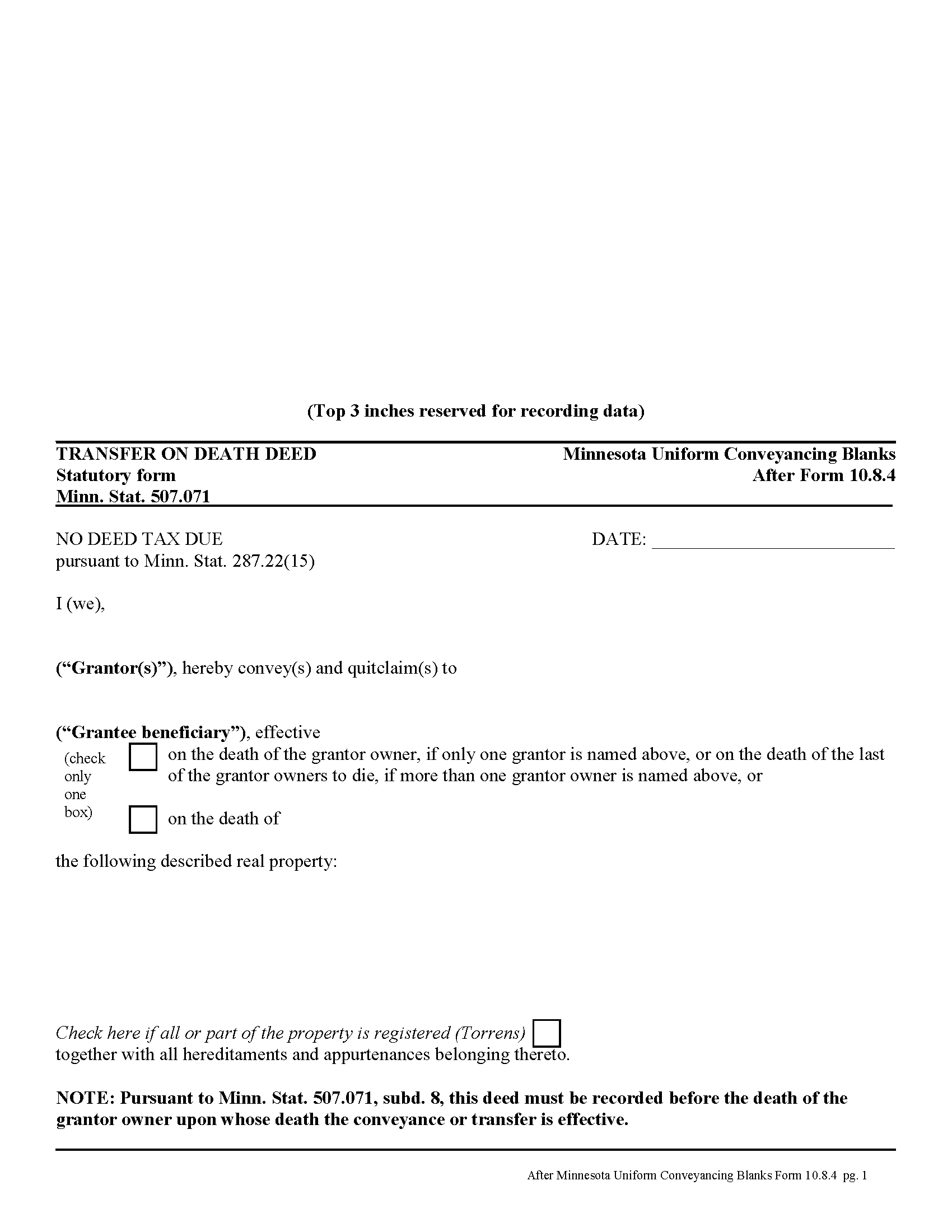Download Minnesota Transfer on Death Deed Legal Forms

Minnesota Transfer on Death Deed Overview

Minnesota's transfer on death deeds are governed by Minn. Stat. 507.071.
Transfer on death deeds are useful estate planning tools for owners of Minnesota real estate. In most cases, when a land owner dies, his/her real property enters the probate system along with the rest of the estate. Some people avoid probate by owning property as joint tenants. The nature of joint tenancy includes the right of survivorship, which, by function of law, automatically distributes a deceased joint tenant's title rights to the surviving tenants. Joint tenants, however, share a current interest in the real property, and all owners must execute any changes or reconveyances. By executing and recording a transfer on death deed instead, owners still avoid the need for probate distribution of that portion of their assets. Transfer on death deeds do NOT pass a current or future interest in the property, so the owner's interests are fully protected while he/she remains alive.
Unlike most other real estate deeds, transfer on death deeds do not convey any rights or interests to the beneficiaries until the grantor owner's death. But, under Minn. Stat. 524.2-702, named beneficiaries must outlive the grantor owners by at least 120 hours to become eligible for the property. The owner retains absolute title to and control over the real property until death. He/she may rent, use, sell or reconvey the land at will, and with no obligation to the beneficiary (Minn. Stat. 507.071, subd. 10). As a result, the beneficiary has no guarantee of any present or future interest in the property. In addition, a "transfer on death deed that is executed, acknowledged, and recorded in accordance with this section is not revoked by the provisions of a will" (subd. 19).
Transfer on death deeds allow flexibility -- in addition to individuals, the grantor owner may "transfer an interest in real property to the trustee of an inter vivos trust even if the trust is revocable, to the trustee of a testamentary trust or to any other entity legally qualified to hold title to real property under the laws of this state" (subd. 9).
Under Minn. Stat. 507.071, transfer on death deeds must:
- convey or assign an interest in real property (subd. 2)
- name one or more grantee beneficiaries (subds. 2 and 4)
- explicitly state that it takes effect at the death of the named grantor owner(s)
- comply with other Minnesota deed requirements including joinder of spouse in conveying homestead (507.02, subd. 2)
- standard recording requirements regarding legibility, recordability, notarization, and original signature (507.24)
- Notice recording statutes (507.34, 508.48, 508A.48)
Ultimately, transfer on death deeds offer a useful alternative for Minnesota land owners who wish to pass property to specific beneficiaries without probate intervention.
NOTE: All actions related to executing, revoking, or otherwise changing a Minnesota transfer on death deed must be submitted for recording in the county where at least part of the land is located, while the grantor owner is alive. (507.071, subd. 8).
Important terms:
Grantor owner: "means an owner named as a grantor in a transfer on death deed upon whose death the conveyance or transfer of the described real property is conditioned" (subd. 1c).
Owner: "means a person having an ownership or other interest in all or part of the real property to be conveyed or transferred by a transfer on death deed" (subd. 1d).
Beneficiary or grantee beneficiary: "means a person or entity named as a grantee beneficiary in a transfer on death deed, including a successor grantee beneficiary" (subd. 1a).
(Minnesota TOD Deed Package includes form, guidelines, and completed example)